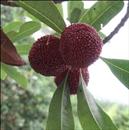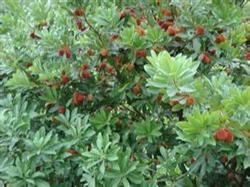Control methods of Myrica rubra fruit fly

In recent years, the occurrence of fruit flies reduced the yield and quality of red bayberry, which seriously affected the economic development of red bayberry. In order to explore the occurrence regularity and control techniques of bayberry fruit fly, the author has observed the pest since 2008, and now basically found out its occurrence in our county and summed up the corresponding control techniques. Drosophila belongs to the genus Diptera, which is one of the main pests of red bayberry, which occurs in the red bayberry orchard and its surrounding environment, and is widely distributed. The morphological characteristics of Drosophila melanogaster showed that the adult was enlarged, the body surface was translucent, the color gradually deepened and hardened. The female adult is larger than the male adult, the end of the abdomen is slightly pointed, the color is light, there are 5 black stripes on the back of the abdomen, 1 obvious black spot on the ventral surface, and 6 abdominal slices on the abdomen. The end of the male adult's abdomen is black and obtusely round, and there are three stripes on the abdomen and back, and the last one is extremely wide. the tarsus of the first pair of feet has a sexual comb and there are four abdominal slices in the abdomen. The pupa is diamond-shaped, from yellowish, soft and gradually hardened to dark brown. The larvae had a blunt head and tail and a black hook-shaped mouthparts on the head, with a total of the third instar larvae. The egg is about 0.5 mm long, white oval, with a contact wire protruding from the front and back, and can be attached to food. Life history and occurrence regularity of Drosophila melanogaster ① life history. The generations of red bayberry flies overlap in the field, it is not easy to divide the algebra, and there is no strict overwintering process. All insect states coexist at the same time, and adults appear when the temperature is above 10 ℃. Under the condition of a temperature of 21: 25 ℃ and an air relative humidity of 75% and 85%, a generation lasts 4-7 days. It only takes about 9 days for Drosophila melanogaster to develop from egg to adult at 25 ℃, and the adult can live for 26-33 days. The occurrence regularity of ②. After the red bayberry entered the ripening stage, the fruit softened, and this period was the peak period of the occurrence of fruit flies. With the continuous harvest of red bayberry, the fruit gradually decreased, and the number of fruit flies decreased. Because fruit flies mainly inhabit in a moist and cool ecological environment with fermented substances, after the bayberry harvest, when the secondary fruit on the tree and the ground fruit under the tree are rotten, the peak period will occur again, and with the gradual disappearance of the residual fruit and ground fruit, the insect population decreases with the lack of food. Generally speaking, the peak period of Drosophila melanogaster occurs in mid-late June and mid-late July, and the occurrence of damage in mid-late June will cause economic losses. Morning and dusk are the peak periods of daily activity of adults. There were significant differences in damage degree and spatial distribution of Drosophila melanogaster on different bayberry varieties. According to the occurrence regularity of Drosophila melanogaster and the characteristics of red bayberry, the following comprehensive control measures can achieve ideal results. ① strengthens orchard management. Reasonable fertilization and irrigation, enhance tree potential, improve tree resistance; scientific pruning, cutting off diseased and dense branches to ensure ventilation and light in the orchard; maintain proper temperature and humidity in the orchard, combined with pruning to clean the orchard, especially to remove rotten debris and fermentation; reduce the source of insects. ② cleans the ground fruit in time. The occurrence of fruit flies in the early ripening stage of red bayberry is small, with the advance of fruit ripening period, the number of fallen fruits increases, and a large number of female flies lay eggs and reproduce on the fallen fruits. Therefore, timely and thorough cleaning of fallen fruits is one of the more effective control methods. ③ liquid entrapment. After falling flowers of red bayberry, mixed entrapment slurry was prepared with trichlorfon, banana, honey and vinegar according to the proportion of 10 ∶ 10 ∶ 6 ∶ 3. 10 parts per mu of trapping and killing adults could make the rate of good fruit more than 95%, and the control effect was ideal. The ④ agent was sprayed on the ground fruit. As bayberry belongs to berries, the pesticide is sprayed directly on the tree or fruit, and the residual pesticides on the fruit are not easy to clean, so chemical pesticides should not be used during the ripening period. However, 1.8% avermectin with low toxicity and low residue can be sprayed before ripening period (that is, mid-May), and the control effect is generally better.
- Prev

Occurrence and Control of Copper deficiency in Waxberry
Bayberry shoot blight is caused by boron deficiency, so planned boron supplementation can eliminate the harm of the disease. Spray 0.1 to 0 during the growth of bayberry. 2 Borax solution for 2 to 3 times can effectively prevent and cure the disease. Root application can also be used, with 0.3 to 0.6 kg of borax per mu for mild boron deficiency and 1.3 per mu for severe boron deficiency.
- Next

Dwarfing cultivation techniques of Myrica rubra
Dongkui red bayberry is an improved variety of Zhejiang specialty, it is the largest fruit variety of red bayberry in China and even in the world, and it is one of the important bayberry variety resources in China. Dongkui bayberry fruit is very large, the ripening period of Huangyan is from late June to early July, the average single fruit weight is 25 grams, the maximum fruit weight is 50 grams. The fruit is round and purple.
Related
- Moge, come on! The staff of the peasant association in the producing area of cantaloupe were frightened when the crowd gathered.
- Causes and Solutions of low Fruit setting rate of Apple
- Symptoms and control measures of passion fruit virus disease
- Fruit growing lesson: how do apple orchards keep high yields?
- Can you build orchards in the mountains? What are the pros and cons?
- How to manage the coloring period of Crisson grape?
- This paper introduces the processing technology of two kinds of fig products.
- How much is a month for retired teachers in rural areas by 2020?
- How can strawberry planting increase sugar content? We should pay attention to management in many aspects.
- What are the cultivation techniques on how to improve the yield of golden fruit?

